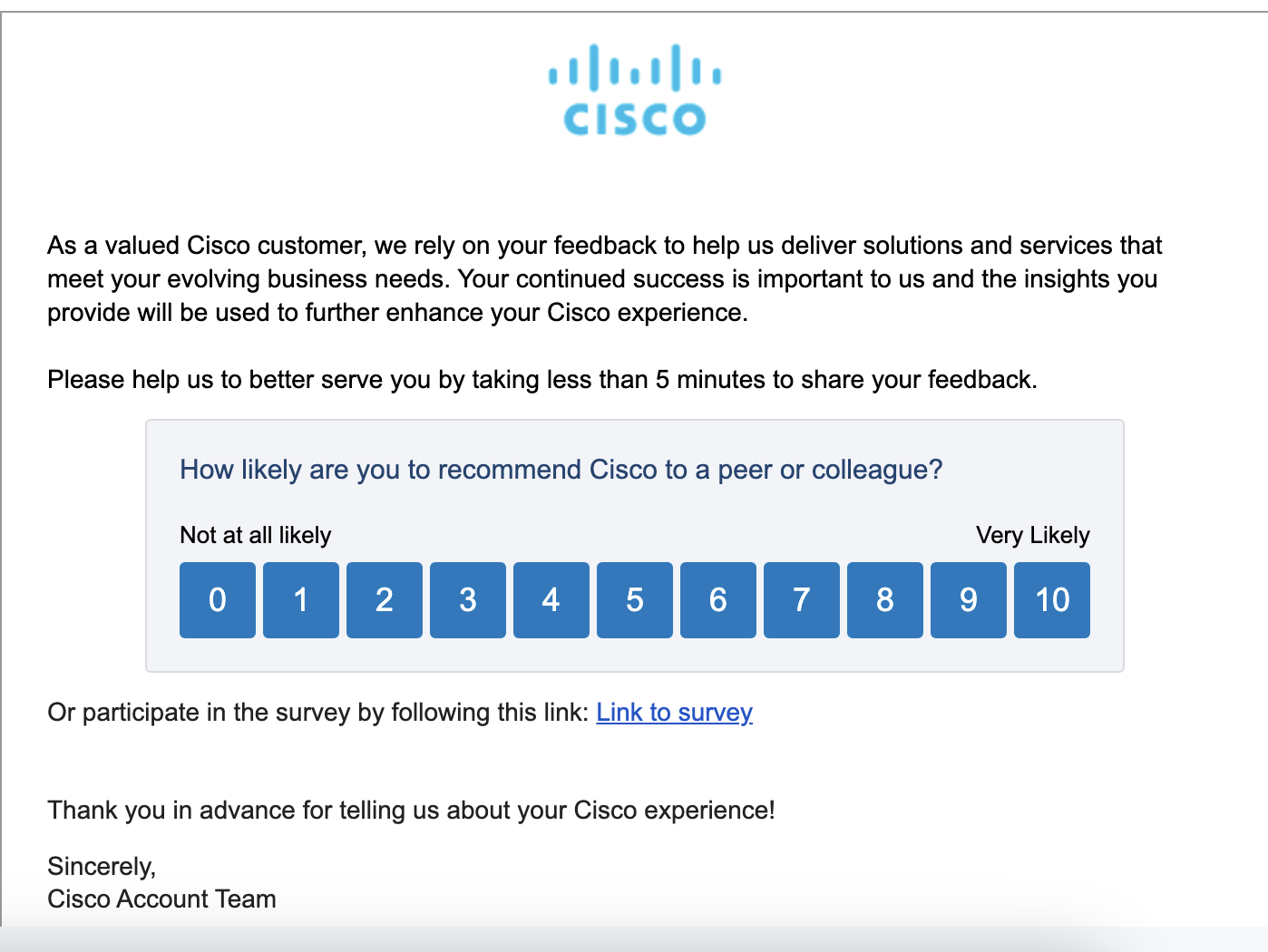There are two products in front of you. Five of your friends advocate for one, and none advocate for the other. Which product are you likely to choose? I'll bet my head you'll choose the one with the referrals.
Regardless of how much media and advertisements we consume daily, word-of-mouth is still the most powerful resource for attracting new customers.
Here’s the kicker. In our scenario above, the product that wasn’t recommended to you doesn’t necessarily mean it’s a “bad” product. It just hasn’t been able to acquire customer advocates, which puts it at a competitive disadvantage.
But what if you could acquire insight about your product with survey software in less than a minute from a single survey? What if you could identify how many of your current users will likely be future advocates and how many are currently experiencing issues? This is where net promoter score, or NPS, comes in.
What is net promoter score?
Net Promoter Score (NPS) is a metric used to measure customer loyalty and satisfaction with a company, product, or service via a customer survey. The purpose of NPS is to gauge customer loyalty to a brand and how likely they are to recommend your product to a peer.
NPS is based on a simple question: "On a scale of 0 to 10, how likely are you to recommend our product/service/company to a friend or colleague?" Promoters (9-10) are enthusiastic. Passives (7-8) might not talk about you. Detractors (0-6) could badmouth you. And it's important to you if your business has more promoters or bad mouthers.
Why is NPS crucial?
NPS is a benchmark for customer satisfaction. It provides actionable insights that drive improvements in customer experience, ultimately leading to increased customer loyalty, retention, and business growth. A few key reasons why NPS is important:
- Measures loyalty: It goes beyond just satisfaction to identify promoters, your most valuable customers who drive growth through word-of-mouth.
- Tracks progress: It lets you benchmark your customer experience over time and see if your efforts are paying off.
- Identifies issues: Asking simple follow-up questions such as "What do you like in the product?" or "What do you want to improve?" can highlight potential issues. Detractor feedback, especially, helps pinpoint areas for improvement in your products or services.
Want to learn more about Survey Software? Explore Survey products.
How to frame NPS survey questions?
Crafting effective NPS survey questions is essential for obtaining meaningful feedback from customers. Here's how you can frame NPS survey questions:
-
Start with the NPS question: Begin by asking the standard NPS question: "On a scale of 0 to 10, how likely are you to recommend [product/service/company] to a friend or colleague?" This question sets the foundation for calculating the NPS score.
- Follow-up open-ended question: After collecting the numerical rating, include an open-ended question to gather qualitative feedback. For example, you can ask, "What is the primary reason for your score?" This allows customers to provide detailed insights into their ratings.
- Demographic questions (optional): Consider including demographic questions to segment responses based on customer characteristics such as age, gender, location, or purchase history. This segmentation can provide deeper insights into different customer groups' perceptions.
Remember to keep the survey short and simple.
Ready to get started on your NPS survey?
Copy our free survey questionnaire that'll make your job easier.
How to run an email survey for NPS?
After framing the questions, you can begin packaging it either through your email marketing software or survey software. The image below is an example of how this email may look like:

Every customer on your email list should receive the NPS survey. You can either blast your survey out all at once or spread it out over the course of a few months.
Task automation software Zapier recommends sending your NPS survey to 1/90th of your users daily for 90 days. So, if you have 1,000 customers on your email list, roughly 11 surveys would be sent daily.
Tip: Target users depending on where they’re at in the product lifecycle. For example, a good time to send someone an NPS survey would be the day after they finished a 30-day trial using your product. A bad time would be directly after a customer started using your product. Let them settle in.
After all current users have received the NPS survey and you’ve gotten an adequate amount of responses (aim for at least 30 percent), it’s now time to calculate your NPS.
Alternatively, you can run the NPS survey as a pop-up on your website or in mobile applications.
How to calculate NPS score?
Fortunately, your NPS calculation isn’t as time-consuming as gathering user responses and can be done in a matter of minutes. Here’s the three-step formula:
How to calculate NPS
- Current users are asked how likely they’d refer your product to a peer. A user will grade their likeliness on a scale from 0-to-10.
- Respondents are broken into three categories: Grades 0-6 are called detractors, grades 7-8 are called passives, and grades 9-10 are called promoters.
- Passive respondents will be disregarded since they are indifferent about your product. Instead, the percentage of detractors will be subtracted from the percentage of promoters.
For example, you’ve received a total of 100 responses. 60 percent of those are promoters, and 20 percent are detractors. 60 - 20 = an NPS of 40. Score possibilities range as low as -100 and as high as 100.
As you may have guessed, detractors aren’t likely to refer your product to a peer – and those in the lower range could very well switch to a competing business. Promoters, however, will likely refer your product to a peer. These are the ones who you should seek out as customer advocates.
.png)
What is a good net promoter score?
So, you’ve got a 35 percent response rate, calculated your NPS, and scored 40. What do you do with this information? How does one determine an optimal net promoter score?
While it’s not always easy to determine a strong NPS, there are some global standards.
- An NPS anywhere around -100 should raise red flags. This means your business should spend a considerable amount of time focusing on ways to increase customer satisfaction.
- An NPS just below 0 is considered average. An NPS at 0 or slightly above it is considered “good” and is an optimal starting point for most businesses.
- An NPS at or above 50 is extremely good. This means your business hits most key factors that contribute to customer satisfaction.
- Finally, an NPS at or above 70 is considered “world-class.” Very few businesses achieve an NPS of this caliber. Essentially, this means nearly every customer would advocate for that product.
NPS survey best practices
At the end of the day, your customers will determine how high or low your NPS will be. However, strategic ways exist to increase response rates, nurture customer advocates, and invite feedback. Below are some best practices on how to do so.
Email subject line
Ideal email subject lines should have just 40-50 characters. Anything beyond this sees a drastic fall-off, so it’s imperative to keep the email subject line concise yet informative when reaching out about your NPS survey.
Here’s an actionable way to craft your email subject line. Specify how many questions (one or two) are on the survey, or let the customer know it’ll take less than 60 seconds to answer.
Follow up email
Follow up in 3-to-7 days if you haven’t received a response regarding your NPS survey. A single reminder could boost response rates easily. The more users participating in your NPS survey, the more robust results.
Customer advocacy
Uplift your promoters with a deal on their existing product, a free demo, early access to a new product feature, some company “swag,” or more. Nurturing these relationships is likely to turn promoters into customer advocates.
You can also prompt promoters to leave a customer review of your product or service. With their permission, you can leverage these positive reviews in marketing materials later on – such as a case study.
Customer service
Engage in some basic customer service! See if there’s any way to resolve a detractor’s issues with your product – though, don’t be discouraged if these efforts go nowhere. While you’d like to make everyone happy, that’s just not a realistic goal.
If it’s clear that unhappy customers can’t be reeled back in, ask for as much feedback as possible with a follow-up question and thank them for participating in the survey. Their insight is just as valuable to your business as the passives and promoters.
Customer loyalty
We know that NPS helps determine customer loyalty and measure customer satisfaction, but exactly why would a brand invest time and resources toward building loyal customers instead of acquiring new ones? Below are some numbers to break it down:
- There is spending power behind customer loyalty. 63% of consumers are willing to spend more money to shop with brands they are loyal to.
Pursuing new customers, while necessary, can be time-consuming and unpredictable. Nurturing your promoters and building lasting customer relationships will undoubtedly lead to higher customer retention.
- Research shows loyal customers are 5x likely to repurchase, 7x likely to try a new product and 4x likely to refer. Seriously, don’t underestimate customer loyalty.
- A 5% increase in customer retention is cheaper than customer acquisition.
Tip: If you're a B2B software or service provider, claim your free G2 profile and get reviews now. Reviews and replying to the reviews are one of the best ways to, shows that you care about customer feedback.
Grow point by point
NPS is “one number you need to grow.” What started out as an email survey blasted out to a few thousand customers would eventually grow into one of the most widely-known benchmarks for determining customer loyalty and satisfaction.
Nearly two decades later, word-of-mouth is still incredibly powerful. Many of us rely on our friends and families for product and brand recommendations all the time. This is why NPS is still an important metric today. It not only puts customer advocates at the forefront but also helps businesses identify pain points in their products or service. Best of all, customers are more willing to respond to an NPS inquiry than most other surveys.
Learn how to prevent churn with retention marketing and ensure long-term success.
This article was originally published in 2018. It has been updated with new information.

Devin Pickell
Devin is a former senior content specialist at G2. Prior to G2, he helped scale early-stage startups out of Chicago's booming tech scene. Outside of work, he enjoys watching his beloved Cubs, playing baseball, and gaming. (he/him/his)

